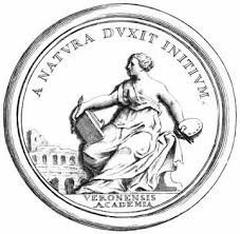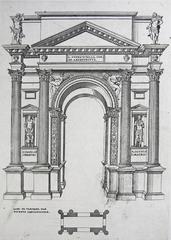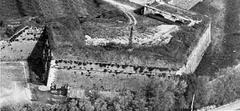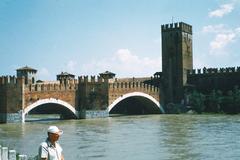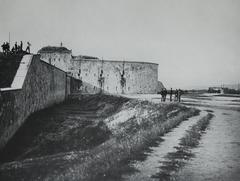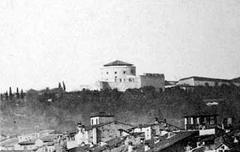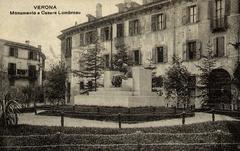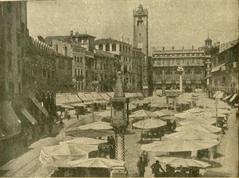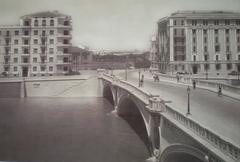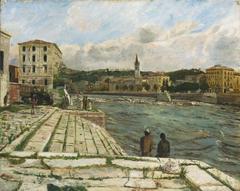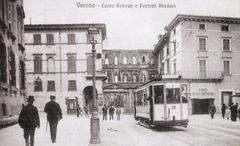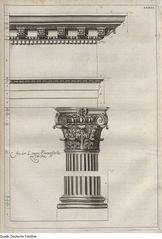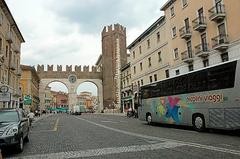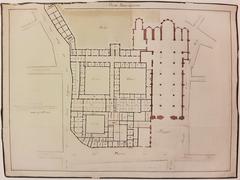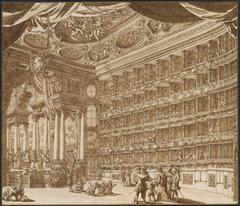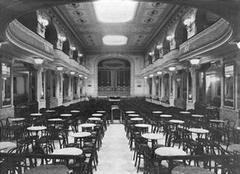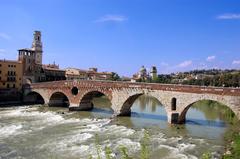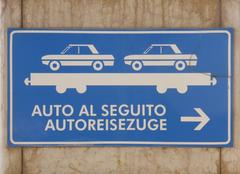
Piazza Bra Verona: Visiting Hours, Tickets, and Historical Sites Guide
Date: 04/07/2025
Introduction
Nestled in the heart of Verona, Piazza Bra is the city’s largest and most iconic public square, where centuries of history, culture, and urban life converge. From its Roman origins and the monumental Arena di Verona to its role as a dynamic cultural and social hub, Piazza Bra is both a living testament to Verona’s past and a vibrant gathering place for locals and visitors alike. This comprehensive guide details everything you need to know about visiting Piazza Bra—covering its history, key landmarks, ticketing, accessibility, travel tips, and nearby attractions—to help you make the most of your visit to this remarkable square (Verona Official Tourism; Arena di Verona Official Site).
Table of Contents
- Introduction
- Historical Overview
- Architectural Landmarks and Urban Identity
- Visiting Piazza Bra: Practical Information
- Visuals and Media
- Frequently Asked Questions (FAQ)
- Conclusion
- Call to Action
- Internal Links
- External Links
Historical Overview
Origins and Etymology
Piazza Bra, affectionately called “the Bra,” is Verona’s central and largest square. Its name derives from “braida,” rooted in the Lombardic “breit” for “broad,” reflecting its expansive size. Initially, it was an open area outside the Roman city walls and gradually evolved into a central urban space (Verona Official Tourism).
Roman Foundations and Early Development
Bordering the ancient Roman walls, Piazza Bra’s origins are entwined with the construction of the Arena di Verona in the 1st century AD—a massive amphitheater that hosted gladiatorial games and public spectacles. This established Piazza Bra as a social and commercial forum, a role it has maintained through history (Arena di Verona Official Site).
Medieval Expansion and Urbanization
The city’s medieval walls (1130–1153) expanded to enclose Piazza Bra, transforming it into a bustling market square. The distinctive Portoni della Bra, with medieval arches and a 19th-century clock, still serve as the main gateway, symbolizing the square’s evolving urban identity. The Santa Lucia fair, a tradition dating to the Middle Ages, continues to enliven the square each December (Verona Municipality).
Renaissance and Baroque Transformations
During the Renaissance, Michele Sanmicheli’s Palazzo degli Honorij framed the western side. The imposing Gran Guardia, begun by Venetians and finished by Austrians, now hosts exhibitions and events. In 1770, the red marble-paved Liston promenade was inaugurated, quickly becoming a popular social walkway.
19th-Century Modernization
The 19th century saw a significant redesign of the Liston and the construction of the neoclassical Palazzo Barbieri (completed in 1836), now Verona’s city hall. The square’s level was lowered for better drainage, gas lighting was introduced, and its gardens and central fountain were added in 1873, enhancing its appeal as a public space.
20th Century to Present: Cultural Significance and Events
Since 1914, the Arena has become world-renowned for open-air opera performances, notably the annual Verona Opera Festival. Piazza Bra continues to thrive as a hub for public events, fairs, and social gatherings, with its cafes and shops forming a lively backdrop for both daily life and special occasions.
Architectural Landmarks and Urban Identity
- Arena di Verona: A remarkably preserved Roman amphitheater, seating up to 30,000 and famous for its acoustics and performances (Arena di Verona Official Site).
- Palazzo Barbieri: The 19th-century neoclassical city hall, symbolizing Verona’s civic life.
- Gran Guardia: A monumental palace for exhibitions and cultural events.
- Portoni della Bra: The medieval gateway with iconic arches and a historic clock.
- The Liston: The marble-paved promenade renowned for its social atmosphere and views (Verona Official Tourism).
The square’s architectural harmony is enhanced by the city’s traditional use of pink limestone and red marble, earning Verona the nickname Marmorina (Architecture Lab).
Visiting Piazza Bra: Practical Information
Visiting Hours
- Piazza Bra: Open 24/7, accessible year-round.
- Arena di Verona: Typically open Tuesday–Sunday, 9:00 AM–7:00 PM (last admission 6:30 PM); hours may vary during performances (Visit Verona).
- Gran Guardia and Palazzo Barbieri: Open during special exhibitions/events (Verona Events Calendar).
Ticket Information
- Access to Piazza Bra: Free.
- Arena di Verona: Tickets required for entry and performances. Purchase online or at the box office; prices vary by event and seat (Arena di Verona Official Site).
- Verona Card: Offers free/discounted entry to major sites and unlimited bus travel; available for 24 or 48 hours (Along Dusty Roads).
Accessibility
Piazza Bra is pedestrianized, flat, and fully accessible to those with mobility challenges. Ramps, accessible restrooms, and dedicated seating are available at the Arena. Public benches and shaded gardens offer rest points throughout the square (JJ Bucket List Travellers).
Travel Tips
- Best times to visit: Early mornings, late afternoons, or evenings for a relaxed atmosphere; summer opera season for a unique experience.
- Nearby attractions: Piazza delle Erbe, Castelvecchio, Juliet’s House, Torre dei Lamberti, Via Mazzini shopping street (Trips & Leisure).
- Dining: Numerous cafes and restaurants offer local cuisine and wines, though prices may be higher than in less central areas (Drift Travel).
- Parking/Transport: No parking directly in the square; use nearby garages. Close to Verona Porta Nuova train station and served by city buses (Full Suitcase).
- Language & Currency: Italian is the local language; English widely spoken in tourist areas. Currency is Euro (€).
Guided Tours and Special Events
Guided tours are available via local operators and the tourism board, often including skip-the-line Arena access. The square hosts regular festivals, markets (especially during Christmas and Easter), concerts, and the renowned summer opera series (Verona Events Calendar).
Visuals and Media
- Arena di Verona exterior and interior
- Palazzo Barbieri’s neoclassical façade
- Piazza Bra aerial views with green spaces and cafés
- Map of Piazza Bra within Verona’s historic center
For immersive previews and virtual tours, visit the official Visit Verona website.
Frequently Asked Questions (FAQ)
Q: What are Piazza Bra’s visiting hours?
A: The square is open 24/7. The Arena di Verona is generally open Tuesday–Sunday, 9:00 AM–7:00 PM; variations occur during events.
Q: Is entry to Piazza Bra free?
A: Yes, Piazza Bra is a public square with free access. Tickets are required for the Arena and special events.
Q: How can I buy Arena di Verona tickets?
A: Online via the official website, at the Arena box office, or with the Verona Card.
Q: Is Piazza Bra accessible for people with disabilities?
A: Yes, it is fully pedestrianized and equipped for wheelchair access.
Q: Are guided tours available?
A: Yes, several guided tours include Piazza Bra and the Arena; bookable online or through the tourism office.
Conclusion
Piazza Bra encapsulates the essence of Verona: a seamless blend of ancient Roman grandeur, architectural beauty, and vibrant contemporary culture. Whether you’re attending an open-air opera, strolling along the Liston, savoring local cuisine, or exploring nearby historic sites, Piazza Bra promises a memorable experience for every visitor. Use this guide to plan your visit and immerse yourself in Verona’s captivating charm.
Call to Action
Enhance your Verona experience with the Audiala app—your source for event listings, guided tours, and local tips. Explore related articles on Verona’s history, dining, and cultural highlights, and follow us on social media for updates and exclusive offers.
Internal Links
External Links
- Arena di Verona Official Website
- Visit Verona Official Tourism Site
- Verona Municipality
- Verona Events Calendar
- World City Trail
- Architecture Lab
- Drift Travel
- JJ Bucket List Travellers
- Trips & Leisure
- Full Suitcase
- Timeless Travel Steps
- Along Dusty Roads
Summary and Final Recommendations
Piazza Bra stands as a vibrant testament to Verona’s layered history and dynamic present, uniting ancient Roman heritage, architectural elegance, and daily Italian life. Anchored by the Arena di Verona and surrounded by neoclassical and medieval landmarks, the square welcomes all with its open, accessible space and lively atmosphere. Whether you’re drawn by grand opera, local gastronomy, or simply the joy of people-watching, Piazza Bra is the perfect starting point for any Verona adventure. Plan your visit using this guide, leverage the Verona Card for convenience, and immerse yourself in the city’s unique culture—your memorable journey begins here (Arena di Verona Official Site; Verona Official Tourism; JJ Bucket List Travellers; Architecture Lab; Verona Events Calendar).











